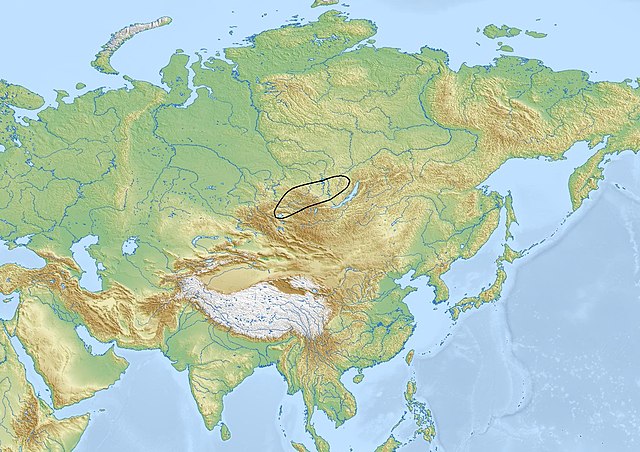AFANASIEVO
CULTURE

Afanasievo
culture
Alternative
names : Afanasevo culture and Afanasevans
Geographical range : South Siberia
Period : Eneolithic
Dates : 3300 BCE — 2500 BCE
Major sites : Minusinsk Basin
Followed by : Okunev culture, Andronovo culture
The
Afanasievo culture, or Afanasevo culture (Russian Afanas'yevskaya
kul'tura; "[the] Afanasevan culture"), is the earliest
known archaeological culture of south Siberia, occupying the Minusinsk
Basin and the Altai Mountains during the eneolithic era, c. 3300
to 2500 BC. It is named after a nearby mountain, Gora Afanasieva,
lit. 'Afanasiev's mountain') in what is now Bogradsky District,
Khakassia, Russia.
David
W. Anthony believes that the Afanasevans were descended from people
who migrated c. 3700–3300 BCE across the Eurasian Steppe from
the pre-Yamnaya culture Repin culture of the Don-Volga region. Because
of its geographical location and dating, Anthony and earlier scholars
such as Leo Klejn, J. P. Mallory and Victor H. Mair have linked
the Afanasevans to the Proto-Tocharian language.
Dating
:
Conventional archaeological understanding tended to date at around
2000–2500 BC. However radiocarbon gave dates as early as 3705
BC on wooden tools and 2874 BC on human remains. The earliest of
these dates have now been rejected, giving a date of around 3300
BC for the start of the culture.
Culture
:
Mass graves were not usual for this culture. Afanasevo cemeteries
include both single and small collective burials with the deceased
usually flexed on his back in a pit. The burial pits are arranged
in rectangular, sometimes circular, enclosures marked by stone walls.
It has been argued that the burials represent family burial plots
with four or five enclosures constituting the local social group.
The
Afanasevo economy included cattle, sheep, and goat. Horse remains,
either wild or domestic, have also been found. The Afanasevo people
became the first food-producers in the area. Tools were manufactured
from stone (axes, arrowheads), bone (fish-hooks, points) and antler.
Among the antler pieces are objects that have been identified as
possible cheek-pieces for horses. Artistic representations of wheeled
vehicles found in the area has been attributed to the Afanasevo
culture. Ornaments of copper, silver and gold have also been found.
Biological
anthropology :
At Afanasevo Gora, two strains of Yersinia pestis have been extracted
from human teeth. One is dated 2909–2679 BCE; the other, 2887–2677
BCE. Both are from the same (mass) grave of seven people, and are
presumed near-contemporary. This strain's genes express flagellin,
which triggers the human immune response; so it was not a bubonic
plague.
Genetics
:
A June 2015 genetic study published in Nature included an analysis
of four females from the Afanasievo culture. Two individuals carried
mtDNA haplogroup J2a2a, one carried T2c1a2, and one carried U5a1a1.
The authors of the study found that the Afanasievo were "genetically
indistinguishable" from the Yamnaya culture. The results indicated
that the expansion of the ancestors of the Afanasievo people into
the Altai was carried out through "large-scale migrations and
population displacements", without admixture with local populations.
The Afanasievo people were also found to be closely related to the
Poltavka culture. According to the authors of the study, the study
underpinned the theory that the Afansievo people were Indo-Europeans,
perhaps ancestors of the Tocharians.
In
a genetic study published in Science in 2018, the remains of 24
individuals ascribed to the Afanasievo culture were analyzed. Of
the 14 samples of Y-DNA extracted, 10 belonged to R1b1a1a2a2, 3
belonged to Q1a2, and 1 belonged to R1b1a1a2a. With respect to mtDNA,
most samples belonged to subclades of U (particularly subclades
of U5), although T, J, H and K was also detected. The authors of
the study cited the results as evidence that the culture emerged
as a result of a migration from the Pontic–Caspian steppe.
Possible
links to other cultures :
Because of its numerous traits attributed to the early Indo-Europeans,
like metal-use, horses and wheeled vehicles, and cultural relations
with Kurgan steppe cultures, the Afanasevans are believed to have
been Indo-European-speaking. Genetic studies have demonstrated a
discontinuity between Afanasievo and the succeeding Siberian-originating
Okunevo culture, as well as genetic differences between Afanasievo
and the Tarim mummies.
Numerous
scholars have suggested that the Afanasevo culture was responsible
for the introduction of metallurgy to China.
Successors
:
The Afanasevo culture was succeeded by the Okunev culture, which
is considered as an extension of the local non-Indo-European forest
culture into the region. The Okunev culture nevertheless displays
influences from the earlier Afanasievo culture. The region was subsequently
occupied by the Andronovo, Karasuk, Tagar and Tashtyk cultures,
respectively.
Allentoft
and coauthors (2015) study also confirms that the Afanasevo culture
was replaced by the second wave of Indo-European migrations from
the Andronovo culture during late Bronze Age and early Iron Age.
Tarim mummies were also found to be genetically closer to the Andronovo
culture than to the Yamnaya culture or Afanasevo culture.
Source
:
https://en.wikipedia.org/
wiki/Afanasievo_culture

